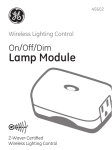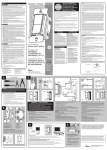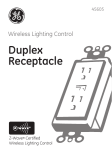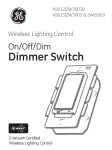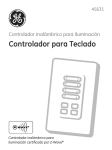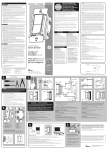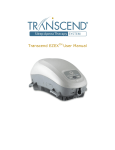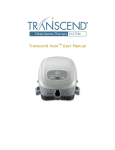Download Advanced Remote
Transcript
Wireless Lighting Control Advanced Remote CONTROL SmartHome 18 ™ • Individual Z-Wave devices • Groups* • Lighting scenes** Control up to 232 Z-Wave enabled devices. *A group turns multiple lights on/off at the same time. **A scene dims or brightens lights in multiple areas to suit your mood. Works with any Z-wave certified lighting module TABLE OF CONTENTS INTRODUCTION............................................................................4-5 Z-WAVE TERMINOLOGY............................................................6-7 INSTALLING BATTERIES ............................................................... 8 Battery Use and Safety........................................................ 8 To Install Batteries................................................................. 8 WIRELESS RANGE........................................................................... 9 Effects of Home Construction on Wireless Range ... Between Z-Wave Enabled Devices................................ 9 NOTES ON SETUP AND CONTROL........................................ 10 Operational Note Regarding These Instructions.. 10 Setup Menus.......................................................................... 10 Entering SETUP Mode........................................................ 10 LIGHTS.............................................................................................. 11 Adding A Device To Your Home Network Without Assigning It To A Specific Number Key...................... 11 Adding A Device To Your Home Network and Assign It To A Specific Number Key..................... 11-12 Controlling Individual Lights........................................... 12 Turning a Light On or Off................................................. 12 Setting a Dimmer’s Brightness Level......................... 12 Removing an Individual Light From A Number Key.................................................................... 12-13 Deleting a Light From Your Network.......................... 13 GROUPS............................................................................................ 13 Creating or Adding a Light to a Group...................... 13 Controlling a Group..................................................... 13-14 Removing a Light from a Group................................... 14 Deleting a Group................................................................. 14 SCENES............................................................................................. 14 Adding a Light to a Scene............................................... 15 Controlling a Scene............................................................ 15 Removing a Light from a Scene................................... 15 Deleting a Scene.................................................................. 16 LABELS.............................................................................................. 16 ALL-ON and ALL-OFF Control................................................. 16 To Turn all devices on or off, perform the following steps..................................................................... 17 Adding or Removing Lights to or from All Control................................................................................ 17 DATE, TIME and DAY SETUP..................................................... 17 Setting the Time................................................................... 17 Setting the Date................................................................... 18 Setting the Day..................................................................... 18 EVENTS............................................................................................. 18 Adding an EVENT................................................................. 18 Random EVENTS.................................................................. 19 Disabling/Re-enabling an EVENT................................. 19 Reviewing EVENTS.............................................................. 19 Deleting an EVENT.............................................................. 19 DOOR LOCKS.................................................................................. 20 Adding a Door Lock.................................................................... 20 Controlling a Door Lock.................................................... 20 Deleting a Door Lock......................................................... 21 THERMOSTATS .............................................................................. 21 Adding a Thermostat......................................................... 21 Controlling a Thermostat................................................. 22 Deleting a Thermostat...................................................... 22 ADVANCED CONFIGURATION ................................................ 22 To Change Advanced Configuration Settings........ 23 ASSOCIATION................................................................................. 23 To Create an Association................................................. 24 To Remove an Association.............................................. 24 REPLICATION (copying information to another remote)........................................................................... 24 CREATE SECONDARY CONTROLLER............................. 24 Copying Information to this Remote...................... 25 PRIMARY CONTROLLER SHIFT (TRANSFER).............. 25 Transferring Primary Controller Information..... 25 RESETTING YOUR NETWORK.................................................. 25 To Reset The Network....................................................... 26 RECOVERING NETWORK INFORMATION............................ 26 FUNCTIONAL OVERVIEW.......................................................... 26 KEEPING THE CONTROLLER AWAKE.................................... 27 INTEROPERABILITY WITH Z-WAVE™ DEVICES................ 27 TROUBLESHOOTING .................................................................. 27 FCC NOTICE.................................................................................... 28 WARRANTY..................................................................................... 29 INTRODUCTION Thank you for purchasing the GE 45633 LCD Remote. This remote allows you to control Z-Wave certified door locks and thermostats as well as Z-Wave lighting devices. Your Z-Wave home control network can include up to 232 Z-Wave enabled devices. You can also set up and control up to 18 individual lights, 18 groups of lights as well as 18 scenes for task or mood lighting. Backlit display with easy to use menu Door Lock Button Check lock status and activate Menu Selection Buttons: Use arrow buttons to scroll between menu items Press OK to select the displayed menu item Setup / Shift Button Press and hold to enter setup mode. You can then add lights to, or delete them from your control network. You can also create or modify groups and scenes, etc. Press and release to SHIFT number buttons from 1 - 9 to 10 -18. Cancel Button Press and release to cancel the current programming operation 4 Additional features include: • Easy to use LCD menu system • Backlit keypad and LCD • Event programming which allows you to set timed events such as turning on all of your lights at a certain time every day. • Control up to 4 Z-Wave certified thermostats for your HVAC Systems. • Control up to 6 Z-Wave certified Door-Locks. Mode Buttons: Thermostat – Use to check and adjust system and temperature settings on a Z-Wave certified thermostat LIGHT – Use to program and/or control individual lights GROUP - Use to program and/or turn multiple lights ON or OFF with one button SCENE – Use to program and/or control multiple lights at preset brightness levels. The same light may be included in multiple scenes. All Button Use to turn ON or OFF all Z-Wave lighting at the same time. Press ALL and then any number button Number Buttons Use to control up to 18 individual lights, 18 groups and 18 scenes. Press & release to turn ON or OFF. Press & hold to adjust brightness. Press the button for numbers 1 – 9; Press SHIFT, then the button for numbers 10-18 5 If this remote is used as the primary controller, you must use it to create your control network. You can use multiple remote controls with your Z-Wave lighting control network; however, only one remote will act as the primary controller. The primary controller must be used to add or delete devices (lights / nodes) from your network. The secondary controllers cannot add or delete devices from your network. Please note that if the primary controller is an SIS (see Z-Wave Terminology below) your secondary controllers can operate as “inclusion controllers” and add/delete devices. NOTE: This product can be operated in one Z-Wave network with Z-Wave certified devices from other manufacturers and/or other applications. The different listening nodes within the network can act as repeaters regardless of vendor. For best results, please read all the remaining instructions before using the remote. Keep this guide for future reference. Z-WAVE TERMINOLOGY Associate: This is the Z-Wave term for linking two units so that a source unit sends commands or information to a destination unit. One example would be where a motion sensor turns on a light when it detects movement. Event: An event is something you want to happen at a specific time and day. This could be everyday, a specific day of the week, Monday through Friday, Saturday & Sunday only, or a one time occurrence. Events can be set up to control an individual light, a group or a scene. Group: Groups can also be thought of as an area or zone. Multiple Z-Wave devices can be turned ON or OFF with a single command when they are placed into a Group. One example would be grouping your porch light, exterior garage lights and patio lights together so that they could all be turned ON if you hear a strange sound in the middle of the night. Home Control Network: Your controllers and every Z-Wave device you have added with the primary controller are linked together into a wireless network. Each device in your network has a unique address assigned to it and cannot be activated by your neighbor’s Z-Wave controller. Include / Exclude: Include and exclude are the formal terms used to describe adding, removing or deleting devices to or from the control network or groups and scenes. Inclusion Controller: An inclusion controller is a secondary controller with the ability to add & delete devices. In order to be an inclusion controller, the secondary controller must have been added to a network that has a static (stationary) primary controller which functions as an SIS (Static update controller with ID Server). An SIS 6 automatically recognizes changes to the network and updates its routing tables accordingly. Light/Node/Device: Node is the technical term used to describe a Z-Wave device in your home control network. Please note that the terms “Node”, “Device” and “Light” all refer to an individual Z-Wave enabled device and are interchangeable within the context of these instructions. Primary Controller: This is the main device used to set up and control your Z-Wave network. There can only be one primary controller and it must be used to add or delete devices. A primary controller can be a portable device like a hand-held remote, a static controller (permanently installed & never moved), a Z-Wave enabled PC or a Z-Wave enabled Ethernet router/bridge/gateway. Replicate: This is the Z-Wave term for copying or transferring the Z-Wave network data to a new controller. This process is also used to update secondary controllers after changes have been made to the control network with the primary controller. Routing Tables: The primary controller creates tables listing every device in the network and which devices can communicate with each other. This information is used by the controller to identify the most efficient route to use when transmitting commands to devices that are out of direct range. Scene: Scenes are normally activity based lighting schemes. A scene lets you establish preset brightness levels for multiple ZWave controlled lights and control them with one command. This is ideal for mood or task lighting. Scene 1 could be the family room lights set to dim for watching TV. Scene 2 could have the same lights set to a different brightness level for other activities like reading or entertaining. Secondary Controller: The Z-Wave network supports multiple controllers so residents can use additional Z-Wave remotes throughout the home. A secondary controller cannot be used to add or delete devices. Slave: Devices within the Z-Wave network are either controllers or slaves. Most AC powered slaves also function as repeaters in the network, and when required, relay the command signals to the destination device. Battery powered devices like motion detectors are typically asleep and do not function as repeaters. SIS: Term used for a static controller which also automatically updates its network information when changes are made to the network. When portable controllers are added to a network with an SIS as its primary controller, the portable controllers become “Inclusion Controllers” and can also add or delete devices. INSTALLING BATTERIES Three “AAA” Alkaline batteries (not included) are required. The 7 remote retains all network settings while replacing the batteries, however, day/date/time settings will need to be re-programmed if the batteries are left out for more than 3 minutes. Battery Use and Safety: • Use only fresh batteries of the required size and recommended type. • Do not mix old and new batteries or different types of batteries • If you do not plan to use the remote for an extended period, remove the batteries. They can leak chemicals that can destroy electronic parts. • Dispose of old batteries promptly and properly. Do not burn or bury them. • Replace fully discharged batteries immediately. To Install Batteries: 1. Open the battery compartment cover by sliding it away from the remote’s body. 2. Note the + and - polarity symbols inside the battery compartment. 3. Insert the batteries, making sure their polarity matches the symbols in the compartment. 4. Replace the cover. WARNING RISK OF FIRE RISK OF ELECTRICAL SHOCK RISK OF BURNS Controlling Appliances: Exercise extreme caution when using Z-Wave devices to control appliances. Operation of the Z-Wave device may be in a different room than the controlled appliance, also an unintentional activation may occur if the wrong button on the remote is pressed. Z-Wave devices may automatically be powered on due to timed event programming. Depending upon the appliance, these unattended or unintentional operations could possibly result in a hazardous condition. For these reasons, we recommend the following: 1. Assign Z-Wave controlled appliances to device numbers 10 – 18 on the GE remote. The likelihood of unintentionally turning on the appliance will be reduced significantly because the “Shift” button will need to be pressed before pressing device numbers 10-18. 2. Z-Wave devices controlling appliances should be removed from “All” control setting. Instructions on how to do this are included in the manual for your GE remote. 3. Do Not include Z-Wave devices in Groups or Scenes if they control appliances. 4. Do Not use Z-Wave devices to control electric heaters or any other appliances which may present a hazardous condition due to unattended or unintentional or automatic power on control. 5. Double check programs for accuracy before using them. NOT FOR USE WITH MEDICAL OR LIFE SUPPORT EQUIPMENT Z-Wave enabled devices should never be used to supply power to, or control t he On/Off status of medical and/or life support equipment WIRELESS RANGE This device exceeds the Z-Wave standard of open-air, line of sight 8 transmission distances of 25 meters or approximately 82 feet. Actual performance in a home depends on the number of walls between the remote controller and the destination device, the type of construction and the number of Z-Wave enabled devices installed in the control network. Most Z-Wave enabled devices act as signal repeaters and multiple devices result in more possible transmission routes which help eliminate “RF dead-spots”. Things to consider regarding RF range: • Each wall or obstacle (i.e.: refrigerator, big screen TV, etc.) between the remote and the destination device will reduce the maximum range by approximately 25-30%. • Brick, tile or concrete walls block more of the RF signal than walls made of wooden studs and plasterboard (drywall). • Wall mounted Z-Wave devices installed in metal junction boxes will suffer a significant loss of range (approximately 20%) since the metal box blocks a large part of the RF signal. Effects of Home Construction on Wireless Range Between Z-Wave Enabled Devices Note: The distances shown in the table below are typical examples. Actual performance in your home will vary. From the Remote (or repeating Z-Wave module) to destination device: Type of Construction Number of Walls or Obstacles Wood Frame w/Drywall Brick, Tile or Concrete Plastic Metal J-Boxes* J-Boxes Plastic Metal J-Boxes* J-Boxes 0** 100’ 80’ 100’ 80’ 1 70’ 56’ 60’ 48’ 2 49’ 39’ 36’ 29’ 3 34’ 27’ 21’ 17’ * For Plug-in Modules or In-Wall Devices Installed in Plastic Junction Boxes ** Line of Sight / No Obstructions Please Note: Z-Wave home control networks are designed to work properly alongside 802.11 wireless computer networks, Bluetooth and other 2.4GHz, 5.8GHz and DECT devices. Some baby cams, wireless video devices and older cordless phones using the 900MHz frequency range may cause interference and limit Z-Wave functionality. Many 900MHz products have a switch to select channel “A” or “B”. You may find that one of these channels will cause less interference than the other. NOTES ON SETUP and CONTROL 9 • Some Z-Wave devices may have to be within two feet of the remote during the setup process. • If the screen displays FAILURE, you have pressed an invalid key or the desired action has not been successfully completed. Please try again. • When controlling Lights, Groups or Scenes: If the display indicates FAILURE, the remote has not successfully communicated with the device. Try again if this occurs. • Dimming a GE brand dimmer to its lowest brightness level Does Not turn the light off even though it may appear off. You must press and release the Off key to actually turn it off. Operational Note Regarding These Instructions: The following instructions direct you to press various buttons or keys on the remote. Unless otherwise noted, the word “press” means “press and release”. The instructions will specifically state “press and hold” if this is required. Setup Menus – Press and hold SETUP button until display changes to LGHT SETUP. Use either arrow key to select desired menu item. LGHT SETUP THERMOSTAT ADV CONFIG GRP SETUP TRANSFER ASSOCIATE SCN SETUP NETWORK ABOUT ALL SETUP EVENTS LOCK SETUP DATE/TIME Entering SETUP Mode Press and hold the SETUP button until the display changes to LGHT SETUP. Use either arrow key to select the desired menu and press OK to enter that mode. LIGHTS 10 In order to control the lights, they must be Z-Wave enabled and you must first add them to your home network. There are several ways to do this using your primary controller. 1. Add lights so that they can be controlled individually using the number keys (maximum of 18). Adding a device to a number key also adds it to your network. If the device number you are trying to add is already associated with another device, the previous information will be overwritten. 2. Add devices to your home network without assigning them to a specific number key. These devices can only be controlled through the GROUP, SCENE or ALL commands. 3. Add a new light to a Group or Scene. LGHT SETUP Add Remove Delete Label To Network To A key NOTE: The new device (Light) should be deleted first before adding to network Adding A Device To Your Home Network Without Assigning It To A Specific Number Key: 1. Enter SETUP and select LGHT SETUP. 2. Press OK. The screen will display ADD. 3. Press OK. The screen will display TO NETWORK. 4. Press OK. The screen will display WAITING in the lower right corner. 5. Press and release the button on the device so that it communicates with the remote. 6. The screen will display SUCCESS to indicate that the Light has been successfully added. 7. The light can now be added to Groups and/or Scenes. Adding A Device To Your Home Network And Assigning It To A Specific Number Key: 1. Enter SETUP and select LGHT SETUP. 2. Press OK. The screen will display ADD. 3. Press OK. The screen will display TO NETWORK. 4. Use either Arrow key to select TO A KEY and then press OK. 5. The display changes to SEL DIGIT. 6. Press a digit key (1-9) for the device location you wish to add. 11 Press SHIFT (SETUP) and the digit key (1-9) if you are adding devices 10 through 18. 7. Press OK. The screen will display LIGHT X and WAITING in the lower right corner. 8. Press and release the button on the device so that it communicates with the remote. 9. When the screen displays SUCCESS, you have successfully added the device to the number key and your network. NOTE: When adding “other” Z-Wave devices with basic on/off commands, these devices must be added to the network, as a light. For example; when adding a duplex receptacle to the network, it must be added by the remote through the light setup function. Controlling Individual Lights You can remotely turn on, off or change a light’s brightness level with this remote but functionality varies by product. Refer to the manual for that device to identify its capabilities. 1. Press and release the LIGHT key to put the remote into “Individual Light Control” mode. The remote will stay in this mode until one of the other modes is selected. 2. Select the light you want to control. (Press and release SHIFT to control lights 10 through 18.) Turning a Light On or Off: • To turn a light on, press the ON key for less than one second. The screen will display the selected LIGHT and ON. • To turn a light off, press the OFF key for less than one second. The screen will display the selected LIGHT and OFF. Setting a Dimmer’s Brightness Level: • To make a light brighter, press and hold the ON key for more than one second. The screen will display the selected LIGHT and BRIGHT. The light will continue to get brighter until the key is released or it reaches its maximum intensity. • To dim the light, press and hold the OFF key for more than one second. The screen will display the selected LIGHT and DIM. The light will continue to get dimmer until the key is released or it reaches in minimum intensity. NOTE: Dimming a GE brand dimmer to its lowest brightness level Does Not turn the light off even though it may appear off. You must press and release the Off key to actually turn it off. If a light has been dimmed to its minimum level and then turned off, it may still appear to be off the next time you turn it on so you will need to increase the brightness level manually or with the remote. Removing An Individual Light From A Number Key This only removes individual number key control. The device is still 12 part of your home control network and can be controlled through the GROUP, SCENE and ALL commands. 1. Enter Setup and select LGHT SETUP. 2. Press OK followed by either arrow key and select REMOVE. 3. Press OK. The screen will display SEL DIGIT. 4. Press a number key (1-9) for the device location you wish to remove. Press SHIFT and the number key (1-9) if you are removing devices 10 through 18. 5. Press OK. The screen will display SUCCESS. Deleting A Light From Your Network This completely removes the device from your home control network and if it is a GE brand device, resets it to its factory default settings. 1. Enter Setup and select LGHT SETUP. 2. Press OK followed by either arrow key and select DELETE. 3. Press OK. WAITING will be displayed in the lower right corner of the screen. 4. Press the button on the device to be deleted so that it communicates with the remote. 5. When the screen displays SUCCESS, you have successfully deleted the light from your network. GROUPS Groups are a collection of lights that you can control with one button. You can set up a maximum of 18 groups. GRP SETUP Add Remove Delete Label Creating or Adding a Light to a Group: 1. Enter SETUP and select GRP SETUP. 2. Press OK. The screen will display ADD. 3. Press OK. The screen will display SEL DIGIT. 4. Press the number key (1-9) for the group you wish to add the device to. Press SHIFT and the number key (1-9) if you are adding a device to groups 10 through 18. 5. Press OK. The screen will display GROUP X and WAITING. 6. Press the button on the device so that it exchanges information with the remote. 7. When the screen displays SUCCESS, you have successfully added the device to your group. 13 Controlling a Group: 1. Press and release GROUP once to put the remote into GROUP Control mode. The screen will display GROUP. The remote will stay in this mode until one of the other modes is selected. 2. Press and release the number key for the group you wish to control (1-9). Press SHIFT and the digit key (1-9) if you are controlling groups 10 through 18. The screen will display the selected Group. • To turn a GROUP on, press and release the ON key for less than one second. The screen will display the selected GROUP and ON. • To turn a GROUP OFF, press and release the OFF key for less than one second. The screen will display the selected GROUP and OFF. Removing a Light from a Group: This only removes the device from a specific group. The device is still part of your home control network and the group still exists (if there were more than one device in the group to start). 1. Enter SETUP and select GRP SETUP. 2. Press OK followed by either arrow key to select REMOVE. 3. Press OK. The screen will display SEL DIGIT. 4. Press a number (1-9) for the group you wish to remove the device from. Press SHIFT and the number (1-9) if you are removing a device from groups 10 through 18. 5. Press OK. The screen will display GROUP X and WAITING. 6. Press the button on the device you wish to remove. 7. When the screen displays SUCCESS, you have successfully removed the device. Deleting a Group: This only deletes the specific group. All of the devices are still part of your home control network. 1. Enter SETUP and select GRP SETUP. 2. Press OK followed by either arrow key to select DELETE. 3. Press OK. The screen will display SEL DIGIT. 4. Press and release the number key (1-9) for the group you wish to delete. Press Shift and the number key (1-9) if you are deleting groups 10 through 18. 5. Press OK. When the screen displays SUCCESS, you have successfully deleted the group. SCENES A scene is a single device or group of devices that can be preset to turn on to a previously specified setting (for example, brightness level). Scenes are ideal for task or mood lighting. You can create a maximum of 18 scenes, containing up to 32 devices per scene. Scenes can include lights from different groups and the same light can be included in multiple scenes. 14 SCN SETUP Add Remove Delete Label Adding a Light to a Scene: 1. Enter SETUP and select SCN SETUP. 2. Press OK. The screen will display ADD. 3. Press OK. The screen will display SEL DIGIT. 4. Press the number key (1-9) for the scene you wish to add the device to. Press SHIFT and the number key (1-9) if you are adding devices to scenes 10 through 18. 5.Press OK. The screen will display SCENE X and WAITING (the remote will time-out if you have not completed steps 6 - 8 within 30 seconds) 6. Press the button on the device that you are adding. 7. Press and hold the button on the device to adjust the brightness level. Release the button when the light is at the desired level. 8. Press the OK button on the remote 9. When the screen displays SUCCESS, you have successfully added the device to a scene. Please note: Non-dimmable On/Off only lighting devices can be added to scenes in either On or Off mode so as an example, the same light could be ON in scene 1 and Off in scene 2. Step 7 above is skipped when adding an On/Off only device to a scene. Controlling a Scene: 1. Press SCENE once to put the remote in SCENE Mode. The remote will stay in this mode until one of the other modes is selected. 2. Press the number key for the scene you wish to control (1-9). Press SHIFT and the number key (1-9) if you are controlling scenes 10 through 18. The screen will display scene and the number selected. • To turn a scene on, press and release the ON key for less than one second. • To turn a Scene off, press and release the OFF key for less than one second. Removing a Light from a Scene: This only removes the device from a specific scene. The device is still part of your home control network and the scene still exists (if there were more than one device in the scene to start). 1. Enter SETUP and select SCN SETUP. 2 Press OK followed by either arrow key to select REMOVE. 3. Press OK. The screen will display SEL DIGIT. 4. Press a number (1-9) for the scene you wish to remove the device from. Press SHIFT and the number (1-9) if you are removing devices from scenes 10 through 18. 15 5. Press OK. The screen will display WAITING. 6. Press the button on the device that you wish to remove. 7. When the screen displays SUCCESS, you have successfully removed the device from the scene. Deleting a Scene: This only deletes the specific scene. All of the devices are still part of your home control network. 1. Enter SETUP and select SCN SETUP. 2. Press OK followed by either arrow key to select DELETE. 3. Press OK. The screen will display SEL DIGIT. 4. Press the number (1-9) for the scene you wish to delete. Press SHIFT and the number key (1-9) if you are deleting scenes 10 through 18. 5. The screen will display the selected Scene; Press OK. 6. When the screen displays SUCCESS, you have successfully deleted the scene. LABELS Individual LIGHTS, GROUPS and SCENES can all be labeled to help identify their function or location in your home. The process is the same for all three. 1. Enter SETUP and select the desired function (LGHT SETUP, GRP SETUP or SCN SETUP). 2. Press OK. The screen will display ADD. 3. Use either Arrow key to select LABEL. 4. Press OK. The screen will display SEL DIGIT. 5. Press the number key (1-9) for the LIGHT, GROUP or SCENE you wish to rename. Press SHIFT and the number (1-9) if you are re-naming 10 through 18. 6. The screen will display the selected LIGHT, GROUP or SCENE. 7. Press OK and then use the #1 On/Off key to scroll through the alphabet/numbers until you reach the appropriate letter or number. 8. Use the right Arrow key to move to the next letter and repeat step 7. 9. Continue this process until your new label is complete. 10. Press OK; the screen will display SUCCESS. ALL-ON and ALL-OFF Control The factory default setting for GE Z-Wave lighting control devices is to be included in All-On and All-Off control. Other brands of Z-Wave enabled lighting control devices may have to be manually added to “All” control. If desired, specific devices can also be configured to ignore the All-On and All-Off commands. There are four possible options available: • EX ON/OFF (exclude from both) • INC ON/OFF (include in both) • EX ON ONLY (excluded from “All On” but still responds to “All OFF” 16 commands) • EX OFF ONLY (excluded from “ALL OFF” but still responds to “ALL ON” commands). ALL SETUP Ex On/Off Inc On/Off Ex On Only Ex Off Only To Turn all devices on or off, perform the following steps: 1. Press ALL once to put the remote in ALL Mode. The remote will stay in this mode until one of the other modes is selected. 2. Press either ON or OFF. Any ON or OFF button can be pressed. (The screen will display ALL ON or ALL OFF depending on what key was pressed). Adding or Removing Lights to or from All Control: 1. Enter SETUP and select ALL SETUP. 2. Press OK. The screen will display EX ON/OFF (exclude from both). 3. Use either Arrow key to select the desired option. 4. Press OK. The screen will display the selected option and WAITING. 5. Press the button on the device that you wish to change. 6. The screen will display SUCCESS. DATE, TIME and DAY SETUP The date, time and day must be setup before programming timed events. Please Note: You will need to reprogram the Time, Date and Day if the batteries are removed for more than three minutes. Date/Time Time Date Setting the Time: 1. Enter SETUP and select DATE/TIME. 2. Press OK. The screen will display TIME. 3. Press OK. The screen will display TIME 12hr. 4. Change the time mode (12hr/24hr) with the #4 key. 5. Adjust the hour by pressing the #1 key. 17 Day 6. Adjust the minutes by pressing the #2 key. 7. Adjust the AM/PM setting with the #3 key (12 hr mode only). 8. Press OK. The screen will display SUCCESS. Setting the Date: 1. Enter SETUP and select DATE/TIME. 2. Press OK. The screen will display TIME. 3. Use either Arrow key to select DATE. 4. Press OK. The screen will display the default date 5. Change the Month by pressing the #1 key. 6. Change the day by pressing the #2 key 7. Change the year by pressing the #3 key 8. Press OK. The screen will display SUCCESS. Setting the Day: 1. Enter SETUP and select DATE/TIME. 2. Press OK. The screen will display TIME. 3. Use either Arrow key to select DAY. 4. Press OK followed by either arrow key to select the current day of the week. 5. Press OK. The screen will display SUCCESS. EVENTS This remote allows you to program up to 9 automated events such as turning on or off your lights at a preset time and day. You must set the time, date and day before programming an Event. EVENTS Add Delete On-off Review Adding an EVENT: 1. Enter SETUP and select EVENTS. 2. Press OK. The Screen will display ADD. 3. Press OK. The Screen will display EVERY DAY. Use Either Arrow key to change the event profile to MON-FRI, SAT-SUN, ONE TIME or a specific Day of the WEEK. 4. Press OK. The Screen will display SEL DIGIT. 5. Press the desired number key. The screen will display EVENT X (number). 6. Press OK. The screen will display ACTUAL for exact time. See below for the RANDOM option. 7. Press OK. The Screen will display EVENT TYPE. 8. Use either arrow key to select the event type (LIGHT, GROUP or SCENE). 9. Press the number key for the Light, Group or Scene you want to 18 control. 10. Press OK. The screen will display ON TIME. 11. Adjust the hour by pressing the #1 key. 12. Adjust the minutes by pressing the #2 key. 13. Adjust the AM/PM setting with the #3 key (12 hr mode only). 14. Press OK. The screen will change to OFF TIME. 15. Repeat steps 11-14 to set the OFF TIME. 16. Press OK to save this event. The screen will display SUCCESS. Random EVENTS: Choose RANDOM in step 7 above to have the EVENT start +/-15 minutes of the Scheduled Time. Continue the programming as shown in step 8 above. Disabling/Re-enabling an EVENT: Once an event has been programmed, it can be disabled or reenabled as desired. 1. Enter SETUP and select EVENTS. 2. Press OK. The screen will display ADD. 3. Use either arrow key to select ON-OFF. 4. Press OK. The screen will display SEL DIGIT. 5. Press the number key for the event you want to disable/re-enable. 6. Press OK. Reviewing EVENTS: 1. Enter SETUP and select EVENTS. 2. Press OK. The Screen will display ADD. 3. Use either arrow key to select REVIEW. 4. Press OK. The screen will display SEL DIGIT. 5. Press the number key for the event you want to review and then press OK. 6. The screen will change to show the event profile set in step 3 of Adding an EVENT. 7. Each subsequent press of the OK button will change the screen to display the various settings for the selected event. Deleting an EVENT: 1. Enter SETUP and select EVENTS. 2. Press OK. The Screen will display ADD. 3. Use either arrow key to select DELETE. 19 4. Press OK. The Screen will display SEL DIGIT. 5. Press the number key for the EVENT you want to DELETE. 6. Press OK. The screen will display SUCCESS. DOOR LOCKS This remote is a Security Enabled Z-Wave controller. It is capable of being part of a secure Z-Wave network. It can include other secure Z-Wave nodes into a network, as well as, being included as a secure node in a network. This remote allows you to program and control up to six Z-Wave certified door locks. These are automatically assigned to number keys 1 – 6 in the order they are added to the network. The Z-Wave protocol requires that both door locks and this remote support AES128 encryption for secure communication so this process may take a little longer than it takes to control a light. Lock Setup Add Delete Adding a Door Lock: 1. Enter SETUP and select LOCK SETUP. 2. Press OK. The screen will display ADD. 3. Press OK. The screen will display WAITING. 4. Press the appropriate button on the door lock or enter the proper code on the lock’s Z-Wave interface*. 5. When the screen displays SUCCESS, you have successfully added the Door Lock to your control network. 6. Repeat steps 1-6 for any additional door locks. Controlling a Door Lock: 1. Press the LOCK button on the remote to enter that mode. The remote will remain in LOCK mode until a different mode is selected. 2. Press the number key associated with the lock you want to control. a. The first key press queries the lock for its current status. Some brands of door locks support this and some do not. If your lock supports this, the remote’s display will show either “Locked” or “Unlocked”. If your lock does not support this, the remote may indicate “Failure” (Be patient; this can take some time if the lock is not responding to the query). b. Press the same lock button a second time to control it. (Pressing a different lock button queries that lock and interrupts the query/control sequence for the first lock). i. Press the top of the number button to lock it. ii. Press the bottom of the button to unlock it. c. The screen will change to display “Lock” and a small icon will 20 appear in the lower right corner. The icon indicates the lock’s current status; locked or unlocked. Please note that actual operation of a door lock varies by manufacturer. Some brands activate the mechanism to allow manual operation of the deadbolt while others automatically extend or retract the deadbolt. Deleting a Door Lock: 1. Enter SETUP and select LOCK SETUP. 2. Press OK. The screen will display ADD. 3. Use either arrow key to select DELETE. 4. Press OK. The screen will display WAITING. 5. Press the appropriate button on the door lock or enter the proper code on the lock’s Z-Wave interface*. 6. When the screen displays SUCCESS, you have successfully deleted the Door Lock from your control network. Please note that if you have multiple locks in your network and you delete one, the remaining locks will automatically shift to the lower number control buttons. Example: Four locks are programmed and you delete the one associated to button #2; locks #3 and #4 will shift to buttons #2 & #3 and button #4 will no longer be associated with a lock. * The setup process for door locks varies by lock manufacturer. Please refer to your lock’s documentation for detailed instructions. THERMOSTATS This remote allows you to program and control up to 4 Z-Wave certified Thermostats. These are automatically assigned to number keys 1 – 4 in the order they are added to the network. Thermostat Add Delete Adding a Thermostat: 1. Enter SETUP and select THERMOSTAT. 2. Press OK. The screen will display ADD. 3. Press OK. The screen will display WAITING. 4. Press the button on the thermostat’s Z-Wave interface*. 5. When the screen displays SUCCESS, you have successfully added the THERMOSTAT to your remote control. 6. Repeat steps 1-5 for additional thermostats. * The setup process for thermostats varies by manufacturer. Please refer to your thermostat’s documentation for 21 detailed instructions. ** The remote is designed to control most Z-Wave lighting control devices, door locks and thermostats sold in North America. If during the inclusion process, a thermostat is not a recognized device (“unknown”), it cannot be added to the network using the normal Setup/Thermostat/Add process and the remote will display “Failure” if the thermostat is not a recognized device. (A thermostat could fail the inclusion process because the specific thermostat device class is not supported by the controller, while the generic device class is supported). This non-recognized thermostat could however be added to a Group or Scene (utilizing the generic device class) in order to provide minimal control (Basic On/ Off commands). Please refer to your thermostat’s instructions to determine the functions of these basic commands. If attempting to add the “unknown” device to the network, please use the Group or Scene inclusions process found in this manual. Please note if you add an “unknown” thermostat to a Group or Scene, this thermostat needs to be the only device part of that Group/Scene. Additionally, deleting an “unknown” device from the Z-Wave network must be done through the Delete option in the Light Setup Menu. Please note: Some thermostats report that they are in the OFF mode when first added to a network. Make sure that you have changed the mode setting to “Heat” or “Cool” before trying to check the room temperature and/or adjust the setpoint (desired temperature). Controlling a Thermostat: The features and functions that can be remotely controlled vary by manufacturer. During setup, the remote queries the thermostat to identify its capabilities and will only display the thermostat’s supported functions. If supported by the thermostat, this remote allows you to check and adjust room temperature and adjust HVAC system modes (Heat, Cool, Auto, Off, etc.). 1. Press and release the THERMOSTAT key (upper right button). 2. The display changes to THERMOSTAT. 3. Press the number key (1 – 4) to select the thermostat you want to control. 4. The display automatically changes to THERMO X and then to SETPOINT. 5. Use either Arrow key to cycle between Setpoint and Mode. a. Setpoint displays the current room temperature and the current setting for the operating mode. Please note: this only works in “Heat” and “Cool” mode. b. “Mode” displays the functional options for your HVAC system (Heat, Cool, Auto, etc.). 6. Select the function you want to control and Press OK. 7. Use the Arrow keys to change the system settings for the selected mode and Press OK. 22 8. The display should briefly change to SUCCESS and then go back to the previous mode screen. Please note that the remote stays in Thermostat mode until a different mode is selected. Deleting a Thermostat: 1. Enter SETUP and select THERMOSTAT. 2. Press OK. The screen will display ADD. 3. Use either arrow key to select DELETE. 4. Press OK. The screen will display WAITING. 5. Press the button on the thermostat’s Z-Wave interface*. 6. When the screen displays SUCCESS, you have successfully deleted the thermostat. * Refer to the thermostat’s instructions for detailed instructions. ADVANCED CONFIGURATION Some Z-Wave devices provide advanced capabilities available only through the use of a remote control like the GE 45633 Advanced Remote. One example is the GE in-wall dimmer which allows the end user to create 3 different dim rates depending upon how the dimmer is activated (manually, via a normal Z-Wave “Dim” command or via an All-On or All-Off Z-Wave command). Please refer to the instructions of your Z-Wave device for available options and specific instructions on changing its advanced configuration. Adv Config Param_ Num Bytes Conf Value To Change Advanced Configuration Settings: 1. Enter SETUP and select ADV CONFIG. 2. Press OK. The screen will display PARAM 0. 3. Use either Arrow key to scroll until the display reads the proper parameter number (1 - 255) as indicated in the Z-Wave device’s instructions. 4. Press OK. The screen will change to NUM BYTES. 5. Use either Arrow key to scroll until the display reads the proper number of bytes (1, 2 or 4) as indicated in the Z-Wave device’s instructions. 6. Press OK. The screen will display CONF VAL. 7. Press OK. The display will change to VAL = 0. 8. Use either Arrow key to scroll until the display reads the proper value (0 - 255) as indicated in the Z-Wave device’s instructions. 9. Press OK. 10. Press the button on the device. 11. The screen will display SUCCESS. ASSOCIATION 23 This remote provides the capability of setting associations between various Z-Wave devices like a motion sensor and a light switch. In this example, the motion sensor is the “source”, or controlling device, and the light switch is the destination or device being controlled. Once the association is created, the motion sensor can transmit a command to the light to turn on when motion is detected and to turn off after a specified period of inactivity. Please note that support for association varies by manufacturer. • GE Z-Wave lighting controls cannot be the source/controlling device however, they can be the destination device (one GE light switch cannot be setup to control another GE light switch but a motion sensor can be setup to control a GE light switch). • Some devices may provide different capabilities based on their “group” settings. As an example, a battery powered door/window sensor could be associated: • To a light switch in group 1. It would then transmit On/Off commands to the switch when it is activated. • To a controller in group 2 to send battery level status or alarm/ tamper alerts. Associate Add Remove To Create an Association: 1. Enter SETUP and select ASSOCIATE. 2. Press OK. The screen will display ADD. 3. Press OK. The screen will display GROUP 1. (Refer to the source device instructions for supported groups and functions). 4. Use the arrow keys to select the appropriate Group. 5. Press OK. The screen will display BUTTON DES. 6. Press the button on the destination/controlled device (example: light switch). The screen will change to BUTTON SOU. 7. Press the button on the source device (example: motion sensor). The screen will briefly display SUCCESS and then the remote will go back to the main association menu. To Remove an Association: 1. Enter SETUP and select ASSOCIATE. 2. Press OK. The screen will display ADD. 3. Use either arrow key to select REMOVE. 4. Press OK. The screen will display GROUP 1. (Refer to the source device instructions for supported groups and functions). 5. Use the arrow keys to select the appropriate Group. 6. Press OK. The screen will display BUTTON DES. 24 7. Press the button on the destination device (example: light switch). The screen will change to BUTTON SOU. 8. Press the button on the source device (example: motion sensor). The screen will briefly display SUCCESS and then the remote will go back to the main association menu. REPLICATION (copying information to another remote) CREATE SECONDARY CONTROLLER You can add a secondary remote to your network, and copy your primary remote’s device and network information to it. This process is also used to update secondary controllers if changes to the network are made with the primary. Transfer Primary Secondary Receive To Send Information to a Secondary Remote: 1. Place the two remotes near each other. 2. Enter SETUP and select TRANSFER. 3. Press OK. The screen will display PRIMARY. 4. Use either arrow key to select SECONDARY. 5. Press OK. The Screen will display SENDING. 6. Refer to the user manual for the secondary remote for programming information. See the following section on “Copying Network/Device Information” if the target remote is a GE 45633 remote. Put the target (secondary) remote into programming mode so that it communicates with the primary remote and receives the network data. The primary remote then copies the network and device information to the new secondary remote. 7. When screen displays SUCCESS you have successfully transferred the information. NOTE: When the remote is transferred, the receiving remote should be reset first before conducting the transfer operation. Copying Information to this Remote (including remote into existing network) 1. Place the two remotes near each other. 2. Refer to the user manual for the primary remote for programming information. Put the primary remote into programming mode so that it sends information to the secondary remote. If the primary remote is a 45633 LCD Remote, refer to the section above on Sending Network Information. 3. On the target 45633, enter SETUP and select TRANSFER. 25 4. Press OK. The screen will display PRIMARY. 5. Use either arrow key to select RECEIVE. 6. Press OK. The Screen will display RECEIVING. 7. When the screen displays SUCCESS you have successfully transferred the information. PRIMARY CONTROLLER SHIFT (TRANSFER) You can transfer all of the 45633’s information to another remote, so it becomes the new primary controller. The 45633 will retain all of its programming; however, it will now be a secondary controller. Transferring Primary Controller Information: 1. Place the two remotes near each other. 2. On the 45633, enter SETUP and select TRANSFER. 3. Press OK. The screen will display PRIMARY. 4. Press OK. The screen will display SENDING. 5. Put the target (new primary) remote into programming mode so that it receives information from the 45633. 6. When the screen displays SUCCESS, you have successfully transmitted the information to the new primary controller. RESETTING YOUR NETWORK (excluding remote from a network) You can reset your network to clear all device and Z-Wave network information from the remote. This does not reset the Z-Wave devices to their factory default. Each device still needs to be deleted in order to reset them. Please refer to the section on “Deleting a Device from Your Network” for details. If you intend to still have an operational network, make sure the remote you are excluding, is not the primary controller. To exclude another controller (secondary controller) from the network, you must do this via the light setup -› delete new option. To Reset The Network: 1. Enter SETUP and select NETWORK. 2. Press OK. The screen will display RESET. 3. Press OK. The screen will display RESET and WAITING in the lower right corner. 4. When the screen displays SUCCESS, you have successfully reset network information. 5. Reset all individual devices as instructed in the section on deleting devices from the network. RECOVERING NETWORK INFORMATION This is typically used to rebuild the routing tables when a lighting device has been moved from its original location. The controller must be primary to initiate a network recovery. 26 To Recover Network Information: 1. Enter SETUP and select NETWORK. 2. Press OK. The screen will display RESET. 3. Use either Arrow key to select RECOVERY. 4. Press OK. The screen will display WAITING. 5. When the screen displays SUCCESS. You have successfully recovered network information. Be patient; the larger the network, the longer it will take to complete this process. FUNCTIONAL OVERVIEW This device is based on the Z-Wave Controller Library and the Remote Controller Generic Device Class. It controls devices through the following Z-Wave Command Classes: • Association Command Class • Basic Command Class • Binary Switch Command Class • Configuration Command Class • Controller Replication Command Class • Encryption Command Class • Lock Command Class • Manufacturer Specific Command Class • Multi-level Switch Version 1 Command Class • Thermostat Command Class • Version Command Class When using the Basic Command Class to control devices the controller will either transmit a value of 0(OFF) or 255(ON), depending on the button pressed. KEEPING THE CONTROLLER AWAKE Under normal circumstances, the controller goes into stand-by mode (sleep) after approximately10 seconds of inactivity (no button presses) in order to extend battery life. It may be desirable to keep the controller awake for longer time periods so that another controller can request Version or Manufacturer Specific information. Press and hold the OK or Cancel button to keep the controller awake for the desired time period. INTEROPERABILITY WITH Z-WAVE™ DEVICES 27 A Z-Wave™ network can integrate devices of various classes, and these devices can be made by different manufacturers. Although every Z-Wave certified product is designed to work with all other Z-Wave certified products, your controller must include the appropriate device classifications in order to control non-lighting Z-wave devices. As an example, the GE 45600 basic remote is designed only for controlling Z-Wave devices using the lighting control classification. The GE 45633 LCD remote can control Z-Wave certified thermostats and door locks as well as lighting. TROUBLESHOOTING • If you are having difficulty adding a device to your network, try deleting it and then adding it. Deleting it will reset the device to its factory default settings and allow it to be added to a new network. • If a light/dimmer appears to be off and not responding to the remotes ON command, try increasing the brightness level. GE dimmers are programmed to turn on to their last used brightness level. Lowering the brightness level of a GE dimmer to its minimum setting does not turn the device off even though it looks like it is off. • Check the Z-Wave FAQs in the Support section of our website for additional information: http://www.jascoproducts.com/z-wave/ GE-Z-Wave-Support.asp. If the unit has no respond or locked up when the battery is in good condition, disconnect one battery momentary to recover to normal operation. FCC NOTICE This device complies with Part 15 of the FCC rules. Operation is subject to the following two conditions: (1) this device may not cause harmful interference, and (2) this device must accept any interference received, including interference that may cause undesired operation. NOTE: This equipment has been tested and found to comply with the limits for a Class B digital device, pursuant to Part 15 of the FCC Rules. These limits are designed to provide reasonable protection against harmful interference in a residential installation. If this equipment does cause harmful interference to radio or television reception, which can be determined by turning the equip- 28 ment off or on, the user should: • Relocate or reorient the TV or radio antenna • Increase the separation between the device and the receiver. Any changes or modifications to the equipment without JASCO’s express consent will void the user’s right to operate this equipment. FCC ID: U2ZZW5303 Compliance with IC Rules and Regulations IC: 6924A-ZW5303 Jasco Products Company Model: 45633 / ZW5303 Object is subject to the following two conditions: 1. This device may not cause interference, and 2. This device must accept any interference, including interference that may cause undesired operation of the device.” This Class B digital apparatus complies with Canadian ICES-003. WARRANTY JASCO Products warrants this product to be free from manufacturing defects for a period of two years from the original date of consumer purchase. This warranty is limited to the repair or replacement of this product only and does not extend to consequential or incidental damage to other products that may be used with this product. This warranty is in lieu of all other warranties, expressed or implied. Some states do not allow limitations on how long an implied warranty lasts or permit the exclusion or limitation of incidental or consequential damage, so the above limitations may not apply to you. This warranty gives you specific rights, and you may also have other rights which vary from state to state. Please contact Customer Service at 800-654-8483 (option 4) between 7:30AM – 5:00PM CST or via our website (www.jascoproducts.com) if the unit should prove defective within the warranty period, JASCO Products Company Building B 10 E Memorial Rd. Oklahoma City, OK 73114. 29 30 31 GE is a trademark of General Electric Company and is used under license by Jasco Products Company LLC, 10 E. Memorial Rd., Oklahoma City, OK 73114. MADE IN CHINA © 2014, JASCO Products Z-Wave is a registered US trademark of Sigma Designs 45633 Ver. 3 rev. 01/06/14 32




































